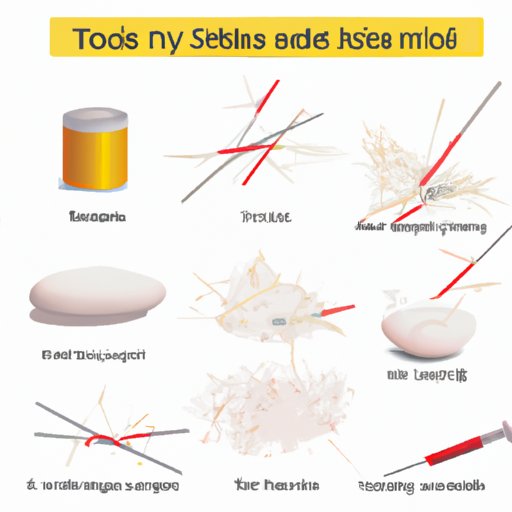
I. Introduction
Removing a splinter that is deeply embedded in your skin can be a daunting task, especially when you cannot see the splinter. In addition to being painful, a splinter can lead to infections and other complications if not removed properly and in a timely manner. This article aims to provide effective and safe methods to remove splinters you cannot see.
II. The Tape Method
The Tape Method is a simple but effective way to remove a splinter that is not visible. Start by washing the area around the splinter and drying it completely. Then, apply a piece of adhesive tape to cover the affected area and press it firmly. Peel the tape off gently in the opposite direction to the splinter’s entry. The tape should pull the splinter out. If not, reapply the tape and try again.
For best results:
- Use strong adhesive tape such as duct tape.
- Ensure the tape is pressed firmly on the skin area.
- Try to pull the tape in the direction the splinter entered.
Advantages:
- The Tape Method is very safe and does not cause any pain.
- The supplies required for this method are readily available.
Limitations:
- This method may not work if the tape is not strong enough.
- The Tape Method may not be effective if the splinter is too deep in the skin.
III. The Baking Soda Method
The Baking Soda Method is an easy and effective way to remove a splinter that is not visible. Mix a tablespoon of baking soda with just enough water to make a paste. Apply the mixture on the affected area and cover it with a plaster. Leave it on for about an hour before removing the plaster. The splinter should come out when you remove the plaster.
Advantages:
- This method is easy to use and can be done at home.
- The paste can help to soothe the skin around the affected area.
Limitations:
- The Baking Soda Method may not work on deep splinters.
- Leaving the plaster on for too long may cause skin irritation.
IV. The Glue Method
The Glue Method involves applying a thin layer of adhesive glue over the area where the splinter is located. When the glue is dry, gently peel it off from the skin, and the splinter should come out with the glue.
For best results:
- Use non-toxic glue, such as school glue or white glue.
- Ensure the glue is fully dry before peeling it off.
- Avoid using this method on sensitive skin or areas around the eyes and mouth.
Advantages:
- The Glue Method is safe and painless.
- The supplies required for this method are readily available.
Limitations:
- This method may not work on splinters that are too deep in the skin.
- Peeling off the glue with force can cause skin irritation.
V. The Epsom Salt Soak
The Epsom Salt Soak method is effective in treating a splinter when it’s not visible. Mix two tablespoons of Epsom Salt in a bowl of warm water. Soak the affected area for about 15-20 minutes. The Epsom Salt helps draw the splinter to the surface, making it easier to remove.
Advantages:
- This method can help to soothe the affected area.
- Epsom salt is an affordable remedy that can be easily found in most stores.
Limitations:
- The Epsom Salt Soak method may not work on very deep splinters.
- If the infusion is too hot, it can cause skin irritation.
VI. The Needle and Tweezer Method
This method is best used when the splinter is visible, but it can also be used when it’s not visible. Start by cleaning the affected area with soap and water. Disinfect the area and tools with rubbing alcohol or hydrogen peroxide. Then, sterilize the tip of a needle and a pair of tweezers using a flame. Grasp the protruding end of the splinter with the tweezers and pull gently, being careful not to break the splinter. Once the splinter is visible, use the sterilized needle to lift the skin directly above the splinter before slipping the top of the tweezers beneath the splinter. Gently pull the splinter out.
Advantages:
- This method can quickly remove a splinter that is not visible.
- This method is most effective when the splinter is visible.
Limitations:
- The needle and tweezers must be sterilized to avoid infection.
- This method can be painful and cause bleeding if not careful.
VII. The Potato Method
The Potato Method is a simple and effective way to draw out a splinter that is not visible. Cut a thin slice of potato and place it on the affected area. Secure it with a bandage or tape. Leave it on for a few hours and remove it. The splinter should come out with the potato.
Advantages:
- The Potato Method is safe and painless.
- Potatoes are readily available and affordable.
Limitations:
- This method may not work on very deep splinters.
- The potato may not adhere to the skin well.
VIII. Conclusion
Removing a deeply embedded splinter can be a challenging task, but there are multiple ways to get it done. Methods like Tape, Baking Soda, Glue, Epsom Salt, Needle and Tweezer, and Potato methods are just some of the at-home remedies recommended by many. It is important to carefully follow the instructions, use the correct tools, and take proper precautions when using any method. Seek professional medical attention if you’re unable to remove a splinter using these methods.
Remember, it’s always better to remove a splinter as soon as possible to avoid complications. Don’t hesitate to seek help when you need it. If you have any comments or questions, leave a message below the article.




